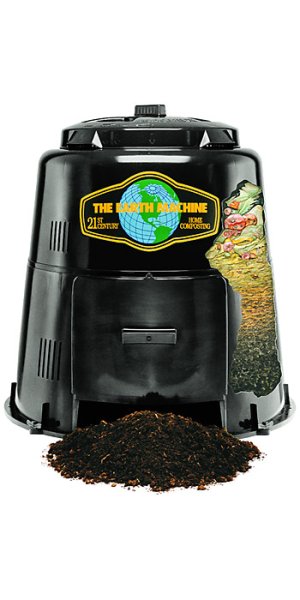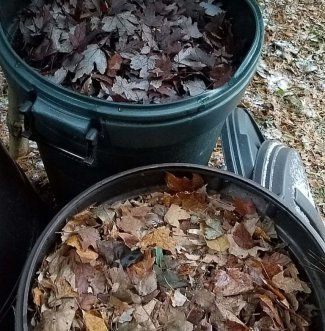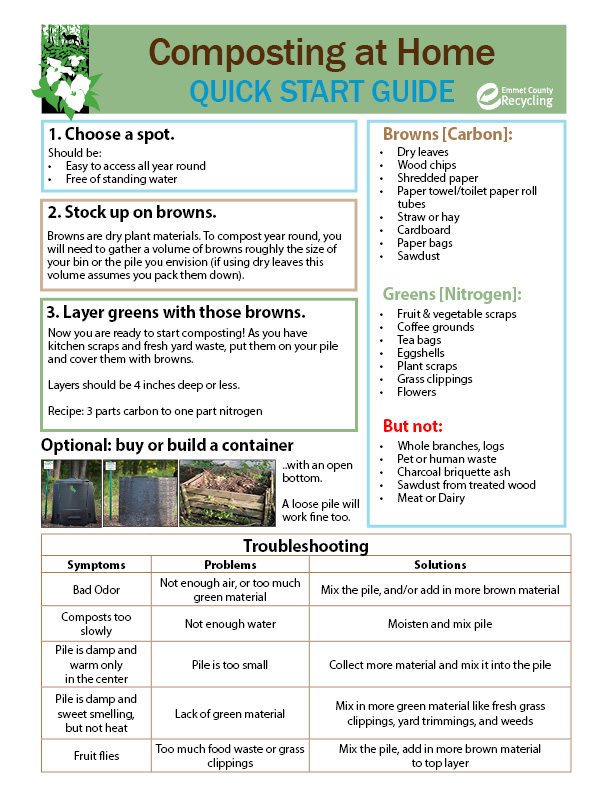Home Composting Information
How To Troubleshooting Winter Composting
Quick Start Guide
How to compost? It depends on what you want to achieve!
The reasons you are considering composting can help you decide how you want to go about it. Your options range from just tossing your yard clippings on a pile and letting nature do all the work to actively managing a multiple pile system to rapidly produce high-quality compost. Does one of the three following statements describe you?
I just want some place to get rid of grass clippings, leaves, twigs, and weeds.
If your aim is simply to dispose of basic yard wastes you can choose an out of the way spot or place a compost bin and start piling your materials up. It will take years for the material to break down and if you continue to add materials there will always be un-decayed items, but this can be a satisfactory method with just one caution: do not mound fresh grass clippings on your pile. They will stink as they decompose (see “Troubleshooting,” below).
I want compost to improve my soil, but I don’t have time to do much to the pile.
If this describes your situation, try “as you go” composting. You’ll eventually need two piles so choose a spot where you’ll have enough room, then place whatever kind of bins you like. Next, you’ll need a source of “browns” (see below). If you’re starting in the fall, you’re in luck because fallen leaves are an ideal and easily available “brown.” If not, you could use dried grass clippings (leave them on the lawn until they are faded, then gather them) or straw (available at farm supply stores).
All you have to do now is add equal parts of “green” (see below) and brown materials as greens become available from your yard and kitchen. Add the green material (up to a three-inch layer at a time) and cover it with a roughly equal amount of brown. Eventually, your first bin will fill and you can use the second while the compost in the first bin finishes decomposing.
Depending on the size of your yard, whether you compost all your grass clippings, and whether you cook with a lot of fresh vegetables and fruits, it may take a year or more for your bin to fill. And, without any further attention, it may be another year or more before the compost in the full bin is finished. If you want to speed the process up, you can use the techniques described in the “air” and “water” sections below.
Many composting manuals talk about piles heating up and killing weed seeds and plant-disease agents. An “as you go” compost pile will not do this. You should be prepared for some seeds to sprout where you use this compost. If you don’t put weeds that have gone to seed in your pile this will be less of a problem.
I want primo compost and I want it now!
Then “batch” composting, the classic method of composting described at length in most composting publications, is for you!
Many people who want to produce excellent compost continuously use three bins: one to build a fresh batch in, one to turn the pile into, and one for the compost to finish in. Each batch moves down the row as it progresses.
You’ll need to gather enough green and brown material to fill one bin all at once-at least one cubic yard-then use the techniques described in the “air” and “water” sections below. A pile built all at once from equal amounts of chopped greens and browns, kept moist, and turned weekly might finish in as little as a month in warm weather. (You’ll have to buy compost if you really want it now.)
The Care & Feeding of Decomposers

Fungi, bacteria, worms, and some insects do the real work of composting. These creatures are all around us breaking down dead plants all of the time. By composting, you’re just setting up a pile with everything they need to thrive. And, the better you provide for them, the faster they’ll do their part and break down your compostables. The following are the things they need:
Greens
You can think of composting fresh plants and kitchen scraps as giving these tiny creatures their protein. Not all are literally green (for example, onions, cauliflower, fresh flowers, and bread all count as “greens”).
Browns
Provide the “carbohydrates” in the decomposers’ diet. Common examples are dry leaves, straw, and sawdust. While your yard and kitchen will generally produce a steady stream of green materials, you may need to stockpile brown materials when they’re available, for example by storing fall leaves for use the next summer.
Air
The creatures that make the best compost need air to thrive. To make compost faster, it helps to turn the pile to introduce air. You can also help air get into the pile by using a special compost aerating tool, available through garden centers and catalogs.
Water
Your pile will break down most quickly if it is kept moist–roughly the wetness of a wrung-out sponge. To keep moisture in, use a plastic bin with a lid or cover your pile loosely with a tarp or a sheet of plastic.
Troubleshooting
Making a Stink
When things go wrong, a compost pile can give off a nasty smell. To fix a smelly pile, add more brown material and turn the pile.
To prevent bad odors: 1) always mix or layer greens with browns, 2) do not mound fresh grass clippings onto the pile without mixing them with brown materials or first allowing them to dry until they begin to fade, 3) don’t put meat scraps, milk products, or greasy foods into the pile, and 4) don’t overwater the pile.
Animal Invasion
Both pets and wild animals may be attracted to your pile. To prevent them from getting in, use a bin which has a lid and small holes or slots for air to enter. Also, meat scraps, bones, dairy products, and greasy foods are more likely to attract animals, so don’t include these in the pile.
Finished!

When you can no longer identify the different materials you put into your pile, your compost is ready to use. Finished compost will also smell earthy–like the forest floor–and will have a crumbly texture. Some sticks and other slow-to-decompose items may remain. You can sift them out, if you like, using a sifter available from a garden supply catalog or made from two-by-fours and fine wire fencing.
Your compost can be mixed with the soil in your garden where it will help keep water in sandy soil or break up dense clay soils. The microorganisms in compost will also make soil nutrients more available to your plants. Compost can be included in soil mix for potted plants or spread as mulch in a 2″-3″ layer.
Don't want to make your own compost, buy ours!
Compost all winter in northern Michigan
(Really, it’s easy!)
Are you ready to compost food scraps all winter? Your need to take into account just three things:
- Do you have plenty of leaves (or other “browns” if you prefer) to layer with the food scraps? You'll want to store them right next to the pile you are building over the winter.
- Do you have plenty of capacity in your bin or pile? A compost pile doesn’t shrink as fast over the winter, so start with a nearly empty bin or bunker. (Just to give you a rough idea, one of our backyard compost bins, if emptied in October when the leaves fall, will easily accommodate food scraps from a family of four all winter.)
- Is your bin/pile in a location that will stay accessible all winter with a minimum of snow-shoveling?
In the spring your pile will “pick up speed” and shrink quickly. This means you will probably have room to simply keep loading it if you like. However, if you would like finished compost sooner, you may want to turn your winter’s accumulation in the late spring and start an new pile to receive fresh food scraps while your over-wintered pile finishes composting fully.



